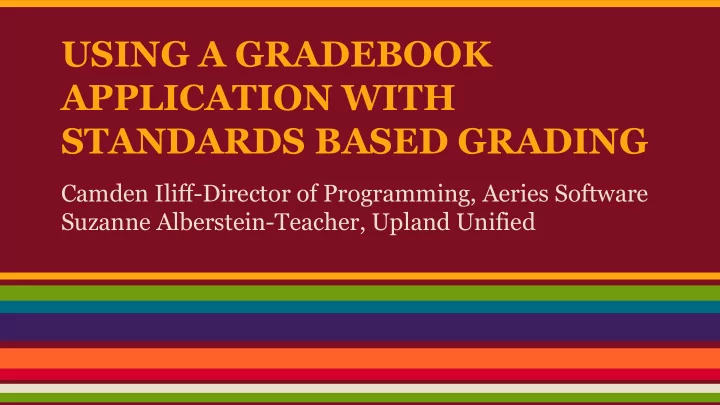

USING A GRADEBOOK APPLICATION WITH STANDARDS BASED GRADING Camden Iliff-Director of Programming, Aeries Software Suzanne Alberstein-Teacher, Upland Unified
IF YOUR GRADING SYSTEM DOESN’T GUIDE STUDENTS TOWARD EXCELLENCE, IT’S TIME FOR SOMETHING COMPLETELY DIFFERENT
PURPOSE OF STANDARDS BASED GRADING 1. What do we want students to learn? 2. How will we know if students learn it? 3. What do we do if students learn it? 4. What do we do if students don’t learn it?
STANDARDS BASED GRADING MEASURES THE MASTERY OF THE LEARNING OBJECTIVES, OR HOW WELL THE STUDENT UNDERSTANDS THE MATERIAL.. IT IS BASED ON A SPECIFIC SET OF STANDARDS THAT STUDENTS NEED TO MEET IN EACH GRADE CONTENT/LEVEL. A standards based approach: ❖ clearly communicates expectations ❖ scores indicate a student’s progress toward the attainment of a standard ❖ is based on complex tasks/DOK ❖ emphasises the most recent evidence of learning ❖ multiple methods of grade calculation
We Need to Challenge the Status Quo ONLY INCLUDE SCORES THAT RELATE TO THE ACHIEVEMENT OF STANDARDS: 1. Be clear about what students must know and be able to do. 2. Don’t give points for extra credit 3. Homework should NOT be included in the student’s score. 4. Late work, effort, participation, etc., should be reported separately.
If teachers aren’t sure of instructional goals, their instructional activities will not be focused, and unfocused instructional activities do not engender student learning. Marzano “Formative Assessment & Standards Based Learning, 2009 USE A VARIETY OF ASSESSMENT METHODS TO COLLECT HIGH QUALITY, ORGANIZED EVIDENCE OF ACHIEVEMENT BASED ON LEARNING TARGET 1. Use multiple measures to determine student achievement. 2. Provide students with multiple opportunities to demonstrate they have acquired the knowledge or skill expected with proficiency. 3. Provide clear descriptions of achievement expectations and score each assessment on clear pre-established criteria. (Rubric) Marzano, 2007 4. Report card grades are based on final proficiency, not an average.
WHY USE RUBRICS? Rubrics can improve student performance by making expectations clear and by showing students how to meet those expectations
HOW DO YOU CREATE RUBRICS? 1. Look at models Show students examples of good and not so good work. 2. List criteria Use the models to begin a list of what counts in quality work 3. Articulate gradations of quality
FORMATIVE vs SUMMATIVE In a balanced assessment system, both summative and formative assessments are an integral part of information gathering. BUT… The key is to think of summative assessment as a means to gauge, at a particular point in time, student learning relative to content standards. Formative assessment is the instructional process, the “practice.” We do not hold students accountable in “grade book fashion” for skills and concepts they have just been introduced to or are learning. It’s only their mastery that counts.
SO HOW DOES ALL THIS LOOK IN A REAL-LIFE GRADE BOOK? AERIES.NET
Recommend
More recommend